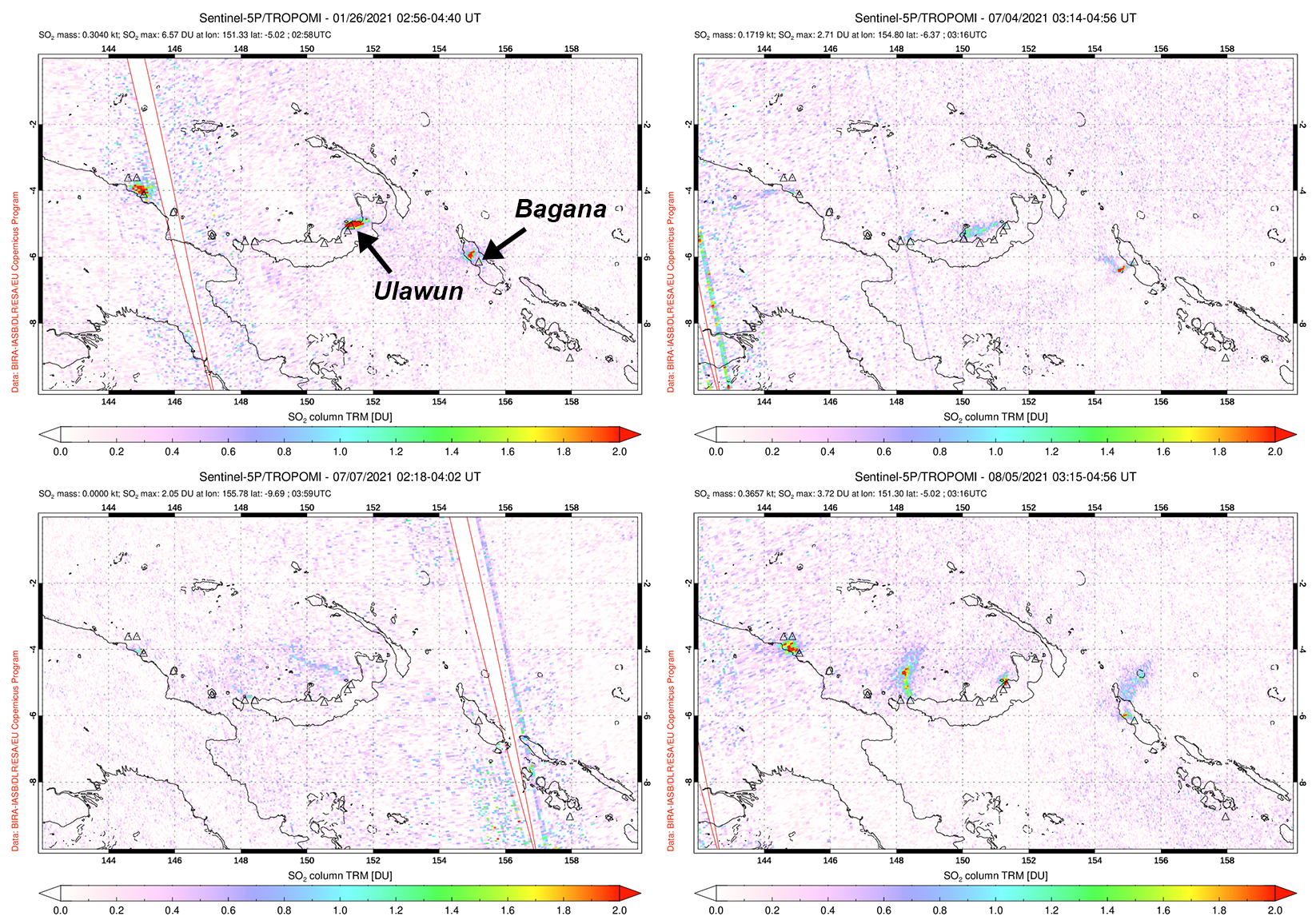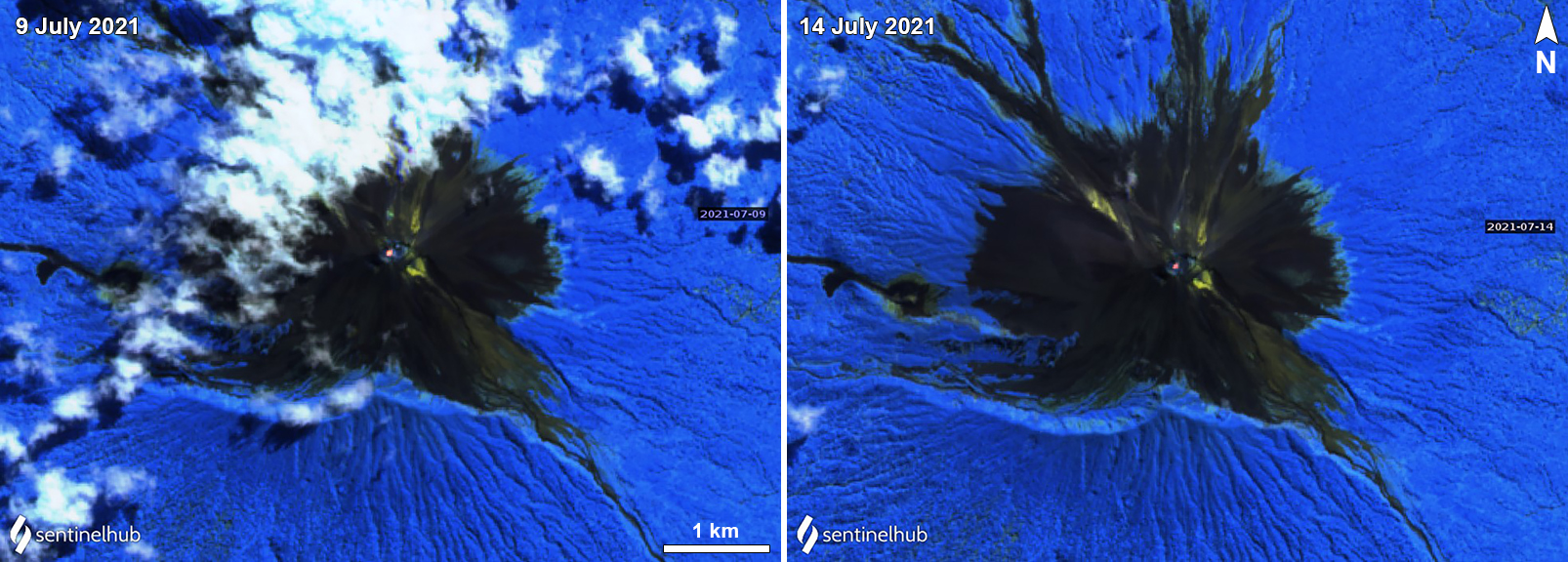Report on Ulawun (Papua New Guinea) — December 2021
Bulletin of the Global Volcanism Network, vol. 46, no. 12 (December 2021)
Managing Editor: Edward Venzke.
Edited by Kadie L. Bennis.
Ulawun (Papua New Guinea) SO2 emissions, ash plumes, and thermal anomalies during July-November 2021
Please cite this report as:
Global Volcanism Program, 2021. Report on Ulawun (Papua New Guinea) (Bennis, K.L., and Venzke, E., eds.). Bulletin of the Global Volcanism Network, 46:12. Smithsonian Institution. https://doi.org/10.5479/si.GVP.BGVN202112-252120
Ulawun
Papua New Guinea
5.05°S, 151.33°E; summit elev. 2334 m
All times are local (unless otherwise noted)
Ulawun is the highest volcano on the Bismarck arc on the N coast of New Britain, located in Papua New Guinea. Historical eruptions date back to 1700; twentieth-century eruptions were mildly explosive until 1967. Its most recent eruption occurred during late June through early October 2019 and was characterized by a new vent, lava fountaining and a flow, and ash plumes (BGVN 44:12). A new eruption was reported during July 2021 and consisted of ash plumes, gas-and-steam emissions, and brief thermal anomalies. This report covers activity during July through November 2021 with information from Rabaul Volcano Observatory (RVO), the Darwin Volcanic Ash Advisory Centre (VAAC), and satellite data.
Activity after October 2019 and throughout 2020 was relatively low; RVO reported that intermittent white gas-and-steam plumes rose from the Main Crater during late December into early February. Occasional emissions rose from WSW flank by the October 2019 vent and lava flow. A webcam sometimes recorded nighttime incandescence from this same area during late December into early January 2020. RVO reported mudflows during mid-January that deposited material on the upper flanks. Seismicity through early February 2020 was low, with RSAM values no higher than 200 units.
During the first half of 2021 activity remained relatively low. Data from the TROPOMI instrument on the Sentinel-5P satellite showed a strong sulfur dioxide concentration on 26 January. Some periods of increased seismicity were recorded during 4-8, 24-25, 26-28, and 29-30 June (figure 27). Occasional high-frequency volcano-tectonic earthquakes were also detected. TROPOMI identified weaker sulfur dioxide emissions drifting generally W on 4 and 7 July (figure 28). Sentinel-2 infrared satellite imagery showed a small thermal anomaly in the summit crater on 9 and 14 July (figure 29), with a weaker anomaly on 24 July partially obscured by a steam plume. The Darwin VAAC issued one notice on 29 July and two on 3 August, reporting ash plumes that rose to 3 and 3.4 km altitude, and drifted E and SSE, respectively, according to pilot reports. Weather clouds prevented clear views in satellite imagery. Another weak SO2 plume was present on 5 August.
In early November RVO reported that very small, discrete, seismic events had been recorded over the previous several months by the seismometer located 5 km from the summit on the SW flank. No surface activity was noted until a small thermal anomaly was identified in satellite images around 0500 on 3 November, according to RVO. At 0800 that same day, RSAM values increased to 100, and by 1115 they had increased further to 1,400. Values continued to fluctuate between 100 and 1,000 units at least through 1300. Tremors were detected on a seismometer at Ulamona (11-12 km NW from the summit) during periods with higher RSAM values. Gas-and-steam emissions continued to be visible above the crater. On 30 November the Darwin VAAC raised the Aviation Color Code to Orange (the second highest level on a four-color scale), due to reports from local observers who described increased seismicity, gas-and-steam emissions, and a small ash eruption on the 29th.
Geological Summary. The symmetrical basaltic-to-andesitic Ulawun stratovolcano is the highest volcano of the Bismarck arc, and one of Papua New Guinea's most frequently active. The volcano, also known as the Father, rises above the N coast of the island of New Britain across a low saddle NE of Bamus volcano, the South Son. The upper 1,000 m is unvegetated. A prominent E-W escarpment on the south may be the result of large-scale slumping. Satellitic cones occupy the NW and E flanks. A steep-walled valley cuts the NW side, and a flank lava-flow complex lies to the south of this valley. Historical eruptions date back to the beginning of the 18th century. Twentieth-century eruptions were mildly explosive until 1967, but after 1970 several larger eruptions produced lava flows and basaltic pyroclastic flows, greatly modifying the summit crater.
Information Contacts: Rabaul Volcano Observatory (RVO), Geohazards Management Division, Department of Mineral Policy and Geohazards Management (DMPGM), PO Box 3386, Kokopo, East New Britain Province, Papua New Guinea; Darwin Volcanic Ash Advisory Centre (VAAC), Bureau of Meteorology, Northern Territory Regional Office, PO Box 40050, Casuarina, NT 0811, Australia (URL: http://www.bom.gov.au/info/vaac/); NASA Global Sulfur Dioxide Monitoring Page, Atmospheric Chemistry and Dynamics Laboratory, NASA Goddard Space Flight Center (NASA/GSFC), 8800 Greenbelt Road, Goddard, Maryland, USA (URL: https://so2.gsfc.nasa.gov/); Sentinel Hub Playground (URL: https://www.sentinel-hub.com/explore/sentinel-playground).




